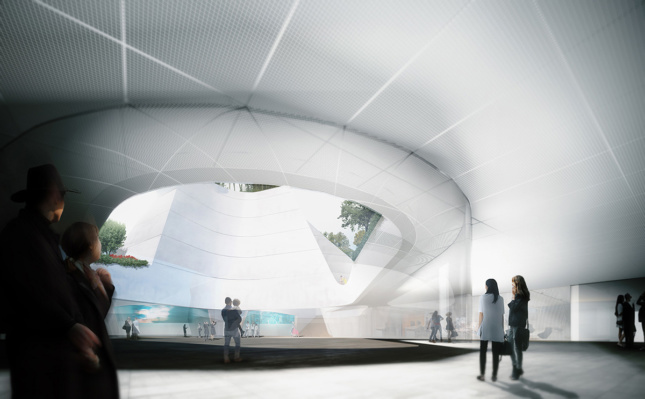Morphosis Architects has unveiled its vision for the upcoming Korean American National Museum in Los Angeles. Slated for a small site in L.A.’s Koreatown district, the two-story cultural space will embody the past, present, and future of the Korean-American experience through the integration of a distinct multi-cultural landscape.
Led by Thom Mayne and Morphosis partner Eui-Saung Yi, the project will be the first permanent home for the institution, which was established in 1991 in order to preserve and interpret the history and achievements of Americans with Korean heritage. According to the architects, the design of the museum’s future building was inspired by Eulho Suh, a Morphosis alum and founder of Suh Architects in Seoul, South Korea. His work is heavily influenced by the concept of “displaced memory” and its embodiment in the physical space. Several elements within Morphosis’ proposal attempt to pay tribute to this idea.
For example, the museum’s plan is structured around the traditional Korean Hanok, or home with a classic courtyard in the middle. The building’s core features a central open space through which everything else—from the fluid ring of galleries to the offices and meeting rooms—is centered around. Even its sweeping concrete facade, which forms an abstract shape that rises from a thin, landscaped podium, isn’t able to give away the surprising scale of the sculptural interior. The bottom of the structure, which dually serves as a welcoming public space, will feature an embossed pattern typically found outside Korean palaces.

With the landscape as the main focus of the architecture, Morphosis set out to create what they call an “allegorical migration” of the Korean-American experience, full of traditional Korean plants mixed with local California flora. This is most easily seen in a rendering of the rooftop sculpture garden which will contain maple, pine, and bamboo trees. By combining these plantings, the museum acknowledges the impact of Korean immigrants in the United States, and the continuing duality of both countries’ existence today.
Morphosis also notes that the museum’s external configuration is meaningful. Located at the corner of 6th Street and Vermont Avenue, guests will enter the museum at the corner of the intersection and be greeted with a triple-height gallery with two intersecting volumes. “By disengaging from the Cartesian direction of the city blocks,” writes Morphosis on its website, “the new orientation signifies the autonomy of the displaced landscape and begins a more dynamic centrifugal experience.”
The Korean American National Museum is scheduled to break ground next year, with an estimated completion planned for 2020.
















